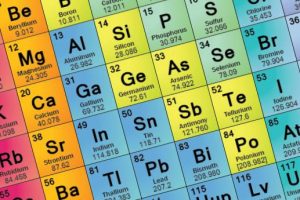Although NPK is always mentioned when discussing plant nutrition and fertilisers, calcium, magnesium and sulphur are technically considered major elements or macro nutrients as well. Deficiencies of these will cause a crop to fail as certainly as a lack of one of the ‘big three’, NPK.
 More information on NPK – nitrogen, phosphorus and potassium or potash
More information on NPK – nitrogen, phosphorus and potassium or potash
Apart from these additional elements, plants also require trace elements in minute quantities.
These are known as micro-nutrients. More information on trace elements or micro-nutrients
Calcium (Ca)
Calcium is required for the plant to utilise and transport other nutrients internally, particularly phosphorus. Without calcium the plants growth will be stunted In soils where the pH is correct for vegetable growing (usually between 5.5 and 7.5) calcium is usually available.
Shortages are easily corrected by liming (agricultural lime is primarily calcium carbonate) or the addition of gypsum. There is a fascinating article on gypsum by Dr Sarvesh Kumar Shah on the site.
Sulphur (S)
Sulphur is vital for protein production and management in the plant. Symptoms of sulphur deficiency are similar to those of lack of nitrogen, low growth rates, yellowing of the leaves etc. and brassicas, which are sensitive to lack of nitrogen, are sensitive to lack of sulphur.
Sulphur deficiency is not usually a problem It is a component of artificial fertilisers, sulphate of ammonia, superphosphates etc. It used to literally fall from the skies when coal fires and coal fired power stations pumped it into the air in the smoke. Clean air means this no longer happens to the same extent.
The main loss of sulphur from the soil is caused by leaching and in the removed crops. Composting kitchen wastes and foliage will return the sulphur to the soil. Green manures will prevent leaching and return sulphur as well.
Lack of sulphur can be corrected by adding sulphur or artificial fertilisers containing sulphur. It is very unlikely you will need to correct sulphur levels and differentiating sulphur deficiency from nitrogen deficiency will require laboratory analysis or educated guesswork
Magnesium (Mg)
Magnesium is essential for the formation of chlorophyll (it is the central atom in the chlorophyll molecule C 55H 72O 5N 4Mg ) and deficiency is quite common.
The visible symptom of magnesium deficiency is yellowing between the veins of leaves, eventually growing to cover the whole leaf.
Because chlorophyll, which is what causes leaves to be green, is the power house of the plant, absorbing the energy from sunlight to process nutrients, lack of chlorophyll results in:
- Reduced yield and stunted growth.
- Increased susceptibility to disease.
- Eventually death of the plant.
Magnesium deficiency is most often seen in tomatoes followed by potatoes and fruits like apples, currants and gooseberries. The reason for this is that all these crops like high levels of potassium to produce high yields and potassium can lock up magnesium, making it unavailable to the plants. This is why better commercial tomato feeds include magnesium as part of their formulation.
Curing a magnesium deficiency is reasonably easy. Plants can quickly absorb magnesium through the leaves, a process known as foliar feeding, so spraying with Epsom salts (magnesium sulphate) is effective. Mix 20g/litre and using a fine spray, cover the plant. Excess solution can be watered into the soil.
To ensure there is enough magnesium available in the soil, instead of using ordinary lime in the rotation you can use dolomite lime which contains around 8% magnesium. You can also obtain magnesium sulphate in bulk as the mineral kieserite.
Do not over use dolomite limestone or kieserite as too much will induce potassium deficiency. Like many things in growing, correct balance is the objective.



